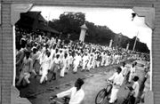
Quit India Movement
Overview
The Quit India Movement or the August Movement (August Kranti) was a civil disobedience
movement launched in India
in August 1942 in response to Mohandas Gandhi's call for immediate independence. Gandhi hoped to bring the British government to the negotiating table. Almost the entire Indian National Congress
leadership, and not just at the national level, was put into confinement less than twenty-four hours after Gandhi's speech
, and the greater number of the Congress leaders were to spend the rest of World War II in jail.
By 1942, Indians were divided over World War II
, as the British Governor-General of India
, Lord Linlithgow
, had unilaterally and without consultation brought India into the war.
Civil disobedience
Civil disobedience is the active, professed refusal to obey certain laws, demands, and commands of a government, or of an occupying international power. Civil disobedience is commonly, though not always, defined as being nonviolent resistance. It is one form of civil resistance...
movement launched in India
India
India , officially the Republic of India , is a country in South Asia. It is the seventh-largest country by geographical area, the second-most populous country with over 1.2 billion people, and the most populous democracy in the world...
in August 1942 in response to Mohandas Gandhi's call for immediate independence. Gandhi hoped to bring the British government to the negotiating table. Almost the entire Indian National Congress
Indian National Congress
The Indian National Congress is one of the two major political parties in India, the other being the Bharatiya Janata Party. It is the largest and one of the oldest democratic political parties in the world. The party's modern liberal platform is largely considered center-left in the Indian...
leadership, and not just at the national level, was put into confinement less than twenty-four hours after Gandhi's speech
Quit India speech
thumb|Procession view at BangaloreThe Quit India speech is a speech made by Mahatma Gandhi on August 8, 1942, on the eve of the Quit India movement. He called for determined, but passive resistance that signified the certitude that Gandhi foresaw for the movement is best described by his call to Do...
, and the greater number of the Congress leaders were to spend the rest of World War II in jail.
By 1942, Indians were divided over World War II
World War II
World War II, or the Second World War , was a global conflict lasting from 1939 to 1945, involving most of the world's nations—including all of the great powers—eventually forming two opposing military alliances: the Allies and the Axis...
, as the British Governor-General of India
Governor-General of India
The Governor-General of India was the head of the British administration in India, and later, after Indian independence, the representative of the monarch and de facto head of state. The office was created in 1773, with the title of Governor-General of the Presidency of Fort William...
, Lord Linlithgow
Victor Hope, 2nd Marquess of Linlithgow
Victor Alexander John Hope, 2nd Marquess of Linlithgow KG, KT, GCSI, GCIE, OBE, PC was a British statesman who served as Governor-General and Viceroy of India from 1936 to 1943.-Early life and family:...
, had unilaterally and without consultation brought India into the war.

